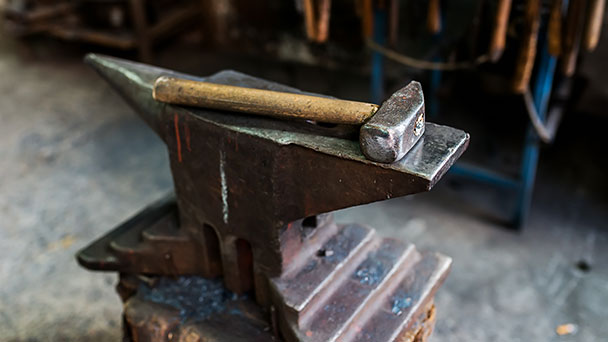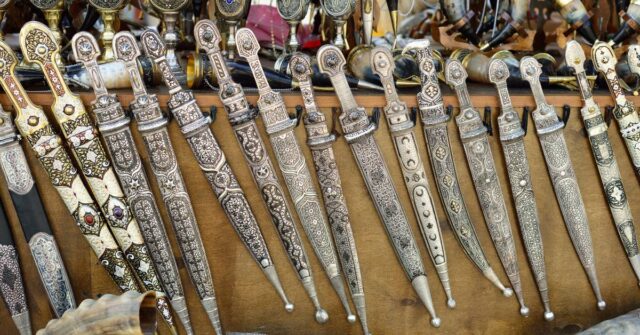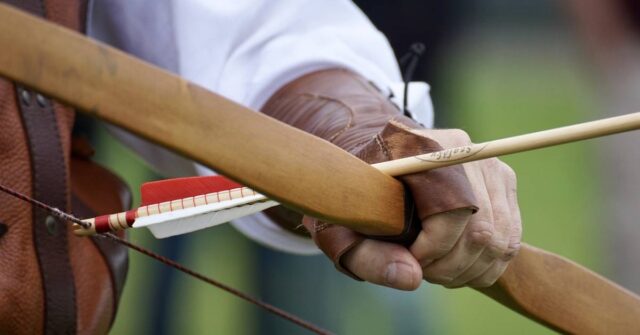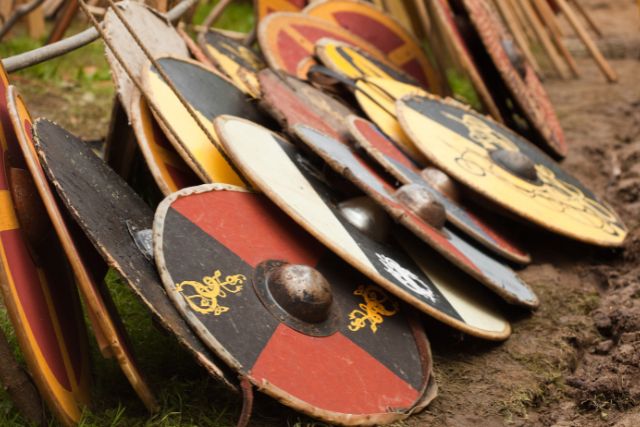In this guide, we will explore the various types of Viking weapons, the materials and techniques used to create them, and how to replicate them authentically for re-enactments.
Introduction to Viking Weapons
Viking weapons hold a special place in the history of warfare and craftsmanship. Stemming from the Viking Age (roughly 793-1066 AD), these weapons were used by Scandinavian warriors to conduct raids and establish their dominance across Europe.
History and Background
The Viking Age was characterized by fierce warriors and skilled craftsmen, who created weapons that were both functional and ornate.
The Norse people developed a unique style of weaponry, which became a symbol of their strength and prowess in battle. The intricate designs and patterns found on these weapons were a testament to their artistic and cultural heritage.
Viking Warrior Culture
At the heart of Viking society was the warrior culture, which was built on values such as bravery, loyalty, and honor. Warriors were expected to be skilled in combat and proficient with various weapons.
Success in battle often led to an increase in social standing, and the quality of a warrior’s weapons reflected their status within the community.

Significance of Authentic Replicas
Authentic replicas of Viking weapons are crucial for accurate historical re-enactments and the study of Norse culture.
By creating faithful reproductions, we can gain a better understanding of the techniques, materials, and artistic styles used by Viking craftsmen. Additionally, these replicas serve as a way to preserve and celebrate this rich and fascinating period of history.
Overview of Viking Weapons
Vikings used a variety of weapons, each with its own unique characteristics and purpose. In this section, we will provide an overview of the most common Viking weapons, which will be explored in greater detail later in this guide.
Swords
Viking swords were often double-edged and featured a straight, wide blade with a tapering point. They were typically used for slashing and thrusting attacks.
Swords were a symbol of wealth and status, as they were expensive to produce and required high-quality materials.
Axes
Axes were a versatile and common weapon among Vikings, used for both combat and everyday tasks. They came in various sizes, from small one-handed axes to large two-handed battle axes.
The design of Viking axes was simple yet effective, with a broad, curved cutting edge and a sturdy wooden handle.
Spears
Spears were a popular weapon for both infantry and cavalry among the Vikings. They consisted of a long wooden shaft with a sharp iron or steel tip.
Spears were primarily used for thrusting but could also be thrown as a missile weapon. They were affordable and easy to produce, making them a common weapon among warriors of all ranks.
Bows and Arrows
Viking archers used longbows made from yew, elm, or ash wood, and arrows with iron or bone tips. Bows and arrows were used for hunting as well as warfare, providing a ranged attack option in battle.
Skilled archers were highly valued in Viking society and played a crucial role in both offense and defense.
Knives and Daggers
Knives and daggers were essential tools for everyday life and self-defense among the Vikings. They came in various sizes and designs, with single-edged or double-edged blades
Often carried in a leather sheath, knives, and daggers were versatile and easily accessible, making them a reliable weapon in close combat situations.

Shields
Shields were an important part of Viking warfare, providing protection from enemy attacks. They were typically round and made from wood, with a metal boss in the center.
Shields were often decorated with paint and leather, displaying the owner’s personal insignia or other designs. They were used both offensively and defensively, allowing warriors to block, parry, and strike their opponents.
Miscellaneous Viking Weapons
While the weapons listed above were the most common, Vikings also used other weapons such as the atgeir (a type of polearm), slings, and throwing axes. These weapons were less prevalent but still played a role in Viking warfare and tactics.
Materials and Techniques
Creating authentic Viking weapon replicas requires an understanding of the traditional materials and craftsmanship techniques used during the Viking Age. In this section, we will explore these aspects in detail and discuss modern alternatives for replication.
Traditional Materials
First, we will look at traditional materials that were used during the time of the Viking Age.
Wood
Wood was a primary material used in the construction of Viking weapons, particularly for handles and shafts. Ash, oak, and other hardwoods were favored for their strength and durability.
Wooden components were shaped using hand tools such as axes, adzes, and knives.
Iron and Steel
Iron and steel were essential materials for creating the blades of Viking weapons. Iron was extracted from bog ore and then refined through a process called smelting.
Steel was created by combining iron with small amounts of carbon, resulting in a stronger and more durable material. Blades were forged by heating and hammering the metal, then quenched and tempered to achieve the desired hardness and flexibility.
Leather
Leather was used for various elements of Viking weapons, such as sheaths, straps, and shield coverings. It was made from the hides of animals like cows, sheep, and deer.
Leatherworking techniques included cutting, stitching, and dyeing to create functional and decorative components.
Modern Alternatives
Now we will look at more advanced alternatives that we have available today.
Aluminum and Stainless Steel
Modern materials like aluminum and stainless steel can be used to create lightweight and corrosion-resistant replicas. While they may not be historically accurate, these materials can be shaped and finished to closely resemble the appearance of traditional iron and steel.
High-Density Foam
High-density foam can be used as a safer alternative to metal for creating replica blades. Foam weapons are often used in live-action role-playing (LARP) and combat re-enactments, where safety is a priority.
These foam replicas can be painted and detailed to look like authentic Viking weapons.
Fiberglass
Fiberglass is a strong, lightweight material that can be used to create durable replicas. It is often used for spear shafts and bow limbs, providing a modern alternative that closely resembles the properties of traditional materials.
Traditional Craftsmanship Techniques
If you want to follow the exact techniques used in the Viking Age you need to learn exactly how they did it back in the day.

Smithing
Smithing was the process of forging metal components for Viking weapons. Blacksmiths used a combination of heat, hammering, and quenching to shape and harden the metal.
This traditional craft required skill, patience, and an understanding of the properties of the materials being used. To replicate this technique, modern blacksmiths can employ traditional tools and methods to forge authentic-looking weapon components.
Woodworking
Woodworking played a significant role in the creation of Viking weapons, as it was used to produce handles, shafts, and shields. Traditional woodworking techniques included carving, shaping, and joining wood using hand tools such as chisels, planes, and saws.
Modern woodworkers can use these same techniques, along with a thorough understanding of historical designs, to create authentic replicas.
Leatherworking
Leatherworking was an essential skill for creating various elements of Viking weapons, from sheaths to shield coverings. Traditional leatherworking techniques involved cutting, stitching, and dyeing leather to create functional and decorative pieces.
Replicating these techniques today requires a combination of historical knowledge and modern leatherworking tools and materials.
Step-by-Step Tutorials
In this section, we will provide step-by-step tutorials for creating each type of Viking weapon replica.
These tutorials will guide you through the process of selecting materials, shaping and assembling components, and applying finishing touches to create an authentic-looking replica.
Creating a Viking Sword
To create a Viking sword replica, start by selecting your materials. For the blade, choose iron, steel, or a modern alternative like aluminum or stainless steel. For the handle, opt for hardwood like ash or oak.
Begin by forging or cutting the blade to the desired shape and size, then refine the edges and taper the point. Create the handle by shaping the wood to fit the tang of the blade, and attach a pommel and crossguard for added stability and protection.
Finish the sword by polishing the blade, adding any desired engravings or decorations, and wrapping the handle with leather or fabric for improved grip.

Creating a Viking Axe
For a Viking axe replica, you will need materials for the axe head (iron, steel, or a modern alternative) and a hardwood handle. Forge or cut the axe head to the appropriate size and shape, with a broad, curved cutting edge and a hole for the handle.
Shape the handle to fit the axe head, ensuring a secure fit and proper balance. Attach the axe head to the handle using a wedge or other traditional method.
Complete the axe by sharpening the cutting edge, adding any desired engravings or decorations, and treating the wood with oil or wax for protection and longevity.
Creating a Viking Spear
To make a Viking spear replica, gather materials for the spearhead (iron, steel, or a modern alternative) and a long hardwood shaft. Forge or cut the spearhead to the desired shape, with a sharp point and a socket for attaching to the shaft.
Shape the shaft to fit the socket, ensuring a secure connection. Attach the spearhead to the shaft using a pin or other traditional method.
Finish the spear by sharpening the tip, adding any desired engravings or decorations, and treating the wood with oil or wax for protection and longevity.
Creating a Viking Bow and Arrows
For a Viking bow replica, select a suitable hardwood like yew, elm, or ash for the bow stave. Begin by shaping the stave into a long, slightly curved piece with a consistent thickness.
Carefully carve the stave into a D-shape, with a flat back and a rounded belly. Create notches at both ends of the stave for the bowstring, made from natural fibers or a modern synthetic material.
Tillering, or adjusting the bend of the bow limbs, is an essential step to ensure an even distribution of force when the bow is drawn. String the bow and test its draw weight and balance.
To create Viking arrow replicas, choose hardwood like ash or birch for the shafts. Cut and shape the shafts to the desired length and diameter, then straighten them using heat and pressure.
Attach iron or bone arrowheads to the shafts using traditional methods like hafting with sinew or glue. Fletch the arrows with feathers, and create a nock at the opposite end of the shaft for the bowstring.
Finish the arrows by treating the wood with oil or wax for protection and longevity.

Creating a Viking Knife or Dagger
To create a Viking knife or dagger replica, select materials for the blade (iron, steel, or a modern alternative) and a hardwood or bone handle.
Forge or cut the blade to the desired size and shape, with a single or double-edged design. Shape the handle to fit the tang of the blade, and attach it securely using traditional methods like riveting or peening.
Complete the knife or dagger by sharpening the edge, adding any desired engravings or decorations, and creating a leather sheath for safe storage and transport.
Creating a Viking Shield
For a Viking shield replica, gather materials such as hardwood like ash or oak for the shield body, metal like iron or steel for the central boss, and leather or fabric for the shield covering.
Cut and shape the wooden planks to form the round shield, then join them together using glue, dowels, or other traditional methods. Attach a central wooden support on the back of the shield for added strength and stability.
Create the metal boss and attach it to the center of the shield using rivets or nails. Cover the shield with leather or fabric, and add any desired paint or decorations.
Finish the shield by attaching a leather or fabric strap on the back for carrying and handling.
Finishing and Detailing
Once your Viking weapon replicas are complete, finishing and detailing are essential steps to achieve an authentic appearance and protect your creations from wear and tear.
Engravings and Decorations
Viking weapons often featured intricate engravings and decorations, such as geometric patterns, runic inscriptions, and animal motifs.
You can replicate these designs using chisels, engraving tools, or a rotary tool with engraving attachments. Research historical examples to ensure the accuracy of your designs, and practice on scrap material before working on your replica.

Applying Authentic Finishes
To achieve an authentic finish on your replicas, choose materials and techniques that closely resemble those used by Viking craftsmen.
For metal components, consider using traditional patination techniques, or apply modern finishes that mimic the appearance of aged metal.
For wooden components, use oil or wax to protect the wood and enhance its natural beauty. For leather elements, use dye or paint to achieve the desired color and finish.
Maintenance and Care
Proper maintenance and care are essential for preserving the appearance and functionality of your Viking weapon replicas. Regularly inspect your weapons for signs of damage or wear, and address any issues promptly to prevent further deterioration.
Blade Care
For metal blades, keep them clean and dry to prevent rust and corrosion. Apply a thin layer of oil or a rust inhibitor to protect the surface. Sharpen blades as needed, using a whetstone or other appropriate sharpening tools.
For foam and fiberglass blades, inspect for damage and repair or replace them as necessary.
Handle and Shaft Care
Inspect wooden handles and shafts for cracks or other signs of damage. Treat the wood periodically with oil or wax to maintain its finish and protect it from moisture.
Ensure that all attachments and fittings are secure and in good condition. For leather-wrapped handles, clean and condition the leather to prevent cracking and deterioration.
Shield Care
Regularly inspect your Viking shield for signs of damage or wear, particularly around the edges and attachment points. Keep the wood and metal components clean and dry, and apply protective finishes as needed.
Repair or replace any damaged or worn components promptly to ensure the shield remains functional and safe for use.

Conclusion
Replicating authentic Viking weapons for re-enactments requires a combination of historical knowledge, traditional craftsmanship techniques, and modern materials and tools.
By carefully selecting materials, shaping and assembling components, and applying authentic finishes and decorations, you can create accurate and functional replicas that celebrate and preserve the rich history and culture of the Viking Age.
Proper maintenance and care are essential to keep your replicas in good condition and ensure they remain a valuable part of your historical re-enactments for years to come.











